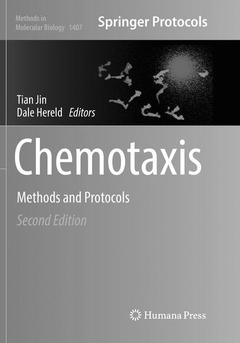Description
Chemotaxis (2nd Ed., Softcover reprint of the original 2nd ed. 2016)
Methods and Protocols
Methods in Molecular Biology Series, Vol. 1407
Coordinators: Jin Tian, Hereld Dale
Language: English
Subject for Chemotaxis:
116,04 €
Disponible chez l'éditeur (délai d'approvisionnement : 15 jours).
Add to cartPublication date: 05-2018
Support: Print on demand
425 p. · 17.8x25.4 cm · Relié
Résumé
/li>Sommaire
/li>Commentaire
/li>
This second edition expands on the first edition with new chapters describing methods for studying cell movement, molecular components involved in chemotaxis, spatiotemporal dynamics of signaling components, and quantitative modeling, as well as several updated chapters from the first edition. Various methods to investigate directional cell growth and movements are presented in Chapters 1-20. These chapters contains experimental procedures to visualize and measure migration behaviors of different kinds of organisms, including chemotropism in the budding yeast; cell growth and migration of D. discoideum; border cell migration in Drosophila; chemotaxis of mouse and human neutrophils; and HIV-induced T cell chemotactic response. Chemotaxis: Methods and Protocols, Second Edition also contains microscopy procedures for studying breast cancer cell migration, tumor cell invasion in vivo, and axon guidance. The book concludes with Chapters 21-27 describing methods that measure spatiotemporal dynamics of signaling components involved in chemotaxis; introduce imaging techniques, such as TRIF, BRET, FRET, and single-molecule microscopy; and mathematical models of experimentally generated chemoattractant gradients. Written in the highly successful Methods in Molecular Biology series format, chapters include introductions to their respective topics, lists of the necessary materials and reagents, step-by-step, readily reproducible laboratory protocols, and tips on troubleshooting and avoiding known pitfalls.
Cutting edge and thorough,Chemotaxis: Methods and Protocols, Second Edition is a valuable resource for anyone who is interested in the diverse methodologies that are propelling chemotaxis research forward.
In Situ Assays of Chemotropism during Yeast Mating.- Imaging Polarization in Budding Yeast Migration of Dictyostelium discoideum to the Chemoattractant Folic Acid.- Mitochondrial Stress Tests Using Seahorse Respirometry on Intact Dictyostelium discoideum Cells.- Studying Chemoattractant Signal Transduction Dynamics in Dictyostelium by BRET.- Wave Patterns in Cell Membrane and Actin Cortex Uncoupled from Chemotactic Signals.- Chemotactic Blebbing in Dictyostelium Cells.- Dissecting Spatial and Temporal Sensing in DictyosteliumChemotaxis Using a Wave Gradient Generator.- Employing Dictyostelium as an Advantageous 3Rs Model for Pharmacogenetic Research.- Identification of Associated Proteins by Immunoprecipitation and Mass Spectrometry Analysis.- Biochemical Responses to Chemically Distinct Chemoattractants during the Growth and Development of Dictyostelium.- Live Imaging of Border Cell Migrationin Drosophila.- ShRNA-Induced Gene Knock-Down In Vivo to Investigate Neutrophil Function.- Studying Neutrophil Migration In Vivo Using Adoptive Cell Transfer.- Intravital Two-Photon Imaging of Lymphocytes Crossing High Endothelial Venules and Cortical Lymphatics in the Inguinal Lymph Node.- Flow Cytometry-Based Quantification of HIV-Induced T Cell Chemotactic Response.- Visualizing Cancer Cell Chemotaxis and Invasion in 2D and 3D.- 4D Tumorigenesis Model for Quantitating Coalescence, Directed Cell Motility and Chemotaxis, Identifying Unique Cell Behaviors and Testing Anti-Cancer Drugs.- An Experimental Model for Simultaneous Study of Migration of Cell Fragments, Single Cells and Cell Sheets.- Axon Guidance Studies Using a Microfluidics-Based Chemotropic Gradient Generator.- Visualization of Actin Assembly and Filament Turnover by In Vitro Multi-Color TIRF Microscopy.- Quantitative Monitoring Spatiotemporal Activation of Ras and PKD1 Using Confocal Fluorescent Microscopy.- Fluorescence Readout of a Patch Clamped Membrane by Laser Scanning Microscopy.- Use of Resonance Energy Transfer Techniques for In Vivo Detection of Chemokine Receptor Oligomerization.- Multi-State Transition Kinetics of Intracellular Signaling Molecules by Single-Molecule Imaging Analysis.- Mathematics of Experimentally Generated Chemoattractant Gradients.- Modeling Excitable Dynamics of Chemotactic Networks.
Ces ouvrages sont susceptibles de vous intéresser

ChemotaxisMethods and Protocols 116,04 €

NeutrophilMethods and Protocols 179,34 €


